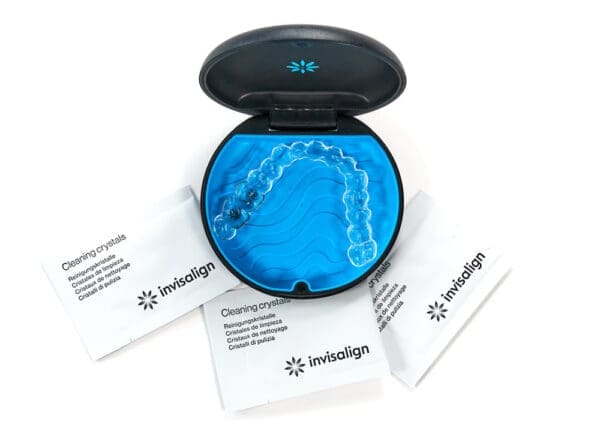Invisalign or fixed appliances in extraction treatment: Which is better?
It’s great to see that researchers are now publishing studies that compare the efficacy of Invisalign with fixed appliances. This latest study conducted on patients who had their first premolar extracted indicated some of the constraints of clear aligners.
Based on our understanding, clear aligners are an option for treating mild to moderate problems in patients who prefer non-fixed appliance treatment. However, some providers and companies have tried to use aligners for more severe problems. Despite the promising advancements, further research must be conducted on this kind of treatment. Therefore, this new study on the matter is both relevant and fascinating.
A team based in South Korea did this study, and the AJO-DDO published the paper.

Ji-Hye Song et al. AJO-DDO online: DOI: https://doi.org/10.1016/j.ajodo.2023.10.014
What did they ask?
They did this study to ask this question.
“What are the effects of Invisalign and Fixed appliances on tooth movements in patients who had extraction of four first premolars”?
What did they do?
They did a retrospective comparison of case series. One orthodontist had treated all the patients with 25 years of experience in fixed appliances and ten years of Invisalign.
The inclusion criteria for the study were:
- Adult patients older than 18 with Class I molars requiring maximum anterior tooth retraction.
- 4 premolar extractions
- ANB less than 6 degrees
They identified a sample of 185 Invisalign patients and included 27 in the study. The control sample was 30 patients whom they had treated with fixed appliances using en masse retraction using temporary anchorage devices.
The researchers obtained data from lateral cephalograms and panoramic radiographs captured before and after the treatment. They analysed many cephalometric measurements and employed straightforward multivariate analyses to detect statistically significant distinctions. As a frequent reader of this blog, you may have already guessed where this is leading.
What did they find?
The treatment duration for the Invisalign group was 38.7 months (95% CI=34.0-43.3) and 32.1 months (95% CI=28.2-35.4) for the fixed appliance treatment. This difference was statistically and clinically significant.
The authors provided a mass of cephalometric data, which I found rather tricky to understand. However, the main points were.
- The Invisalign group showed a 1mm greater increase in overbite and a 7o increase in inter-incisal angle than the fixed appliance patients.
- Compared to the fixed appliance group, the Invisalign group had 5o greater lingual tipping of the upper incisors and 3.6o more mesial tipping for the upper molars.
I felt that most other measurements were “white noise”, so I hope I have identified the important outcomes.
Their overall conclusions were:
“The Invisalign group showed more statistically significant tipping of the maxillary central incisors, distal tip of the maxillary canines and mesial tipping of the maxillary molars compared with the fixed appliance treatment”.
What did I think?
If you’re a regular reader of this blog, you might have noticed that I hardly ever discuss retrospective studies since they are susceptible to selection bias due to their study design. Unfortunately, the same is true for this study because the inclusion criteria for the final sample were not clearly defined. Nevertheless, I chose to review this study because it could be considered a first step towards much-needed research on aligners. However, it’s worth noting that the findings of this study should be approached with a high degree of uncertainty.
I have been able to analyze a report that was quite complex due to its numerous variables. The report suggests that Invisalign lacks control in comparison to fixed appliances. This has made me wonder if Invisalign is similar to the old-style removable appliances that were equipped with finger springs and labial bows, which were quite popular in the UK during the 1960s. These appliances simply tipped teeth. Consequently, the treatment results were characterised by loss of anchorage and tipped incisors. Fortunately, these removable appliances were superseded by fixed appliances.
We also need to consider that the differences they detected were relatively small and certainly not clinically significant. As a result, they represent a trend of lack of control that is inherent in aligner mechanics.
Final thoughts
While this study provides some valuable information, its limitations make it necessary to exercise caution in interpreting its results. However, we can use the findings to shape the design of a randomised trial urgently required to evaluate the effectiveness of aligners and fixed appliances. I hope that someone can conduct such a study soon.

Emeritus Professor of Orthodontics, University of Manchester, UK.
Several years ago, as previously documented, it was established that clear aligners, replacing antiquated removable appliances, exhibit limitations in their efficacy (Brodie). The inherent removable nature persists unchanged, defying any augmentation. Expedited routes and miraculous interventions are absent. The challenge lies in the inability to establish requisite anchorage for effectual tooth translation using clear aligners. Despite the treatment of over 15 million patients, including those at preeminent global universities, a notable absence persists in substantial randomized controlled trials (RCTs) that rigorously investigate this subject. The imperative for such research was initially underscored by Proffitt and Ackerman in 2002 (American Journal of Orthodontics and Dentofacial Orthopedics).
Are there too many KOLs in the fields?